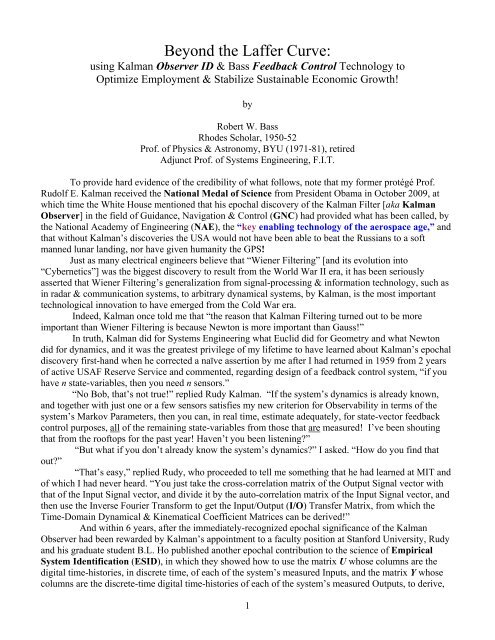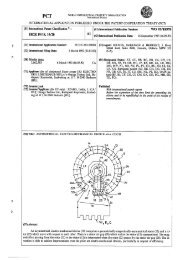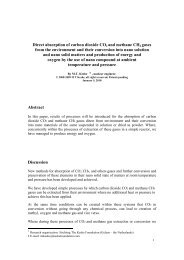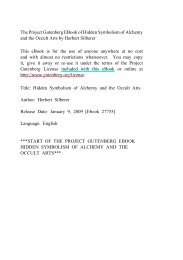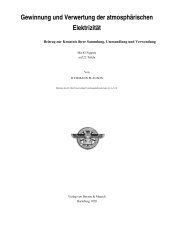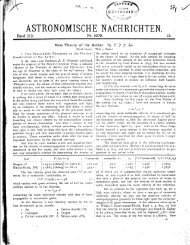Beyond the Laffer Curve: - Rex Research
Beyond the Laffer Curve: - Rex Research
Beyond the Laffer Curve: - Rex Research
Create successful ePaper yourself
Turn your PDF publications into a flip-book with our unique Google optimized e-Paper software.
<strong>Beyond</strong> <strong>the</strong> <strong>Laffer</strong> <strong>Curve</strong>:<br />
using Kalman Observer ID & Bass Feedback Control Technology to<br />
Optimize Employment & Stabilize Sustainable Economic Growth!<br />
by<br />
Robert W. Bass<br />
Rhodes Scholar, 1950-52<br />
Prof. of Physics & Astronomy, BYU (1971-81), retired<br />
Adjunct Prof. of Systems Engineering, F.I.T.<br />
To provide hard evidence of <strong>the</strong> credibility of what follows, note that my former protégé Prof.<br />
Rudolf E. Kalman received <strong>the</strong> National Medal of Science from President Obama in October 2009, at<br />
which time <strong>the</strong> White House mentioned that his epochal discovery of <strong>the</strong> Kalman Filter [aka Kalman<br />
Observer] in <strong>the</strong> field of Guidance, Navigation & Control (GNC) had provided what has been called, by<br />
<strong>the</strong> National Academy of Engineering (NAE), <strong>the</strong> “key enabling technology of <strong>the</strong> aerospace age,” and<br />
that without Kalman’s discoveries <strong>the</strong> USA would not have been able to beat <strong>the</strong> Russians to a soft<br />
manned lunar landing, nor have given humanity <strong>the</strong> GPS!<br />
Just as many electrical engineers believe that “Wiener Filtering” [and its evolution into<br />
“Cybernetics”] was <strong>the</strong> biggest discovery to result from <strong>the</strong> World War II era, it has been seriously<br />
asserted that Wiener Filtering’s generalization from signal-processing & information technology, such as<br />
in radar & communication systems, to arbitrary dynamical systems, by Kalman, is <strong>the</strong> most important<br />
technological innovation to have emerged from <strong>the</strong> Cold War era.<br />
Indeed, Kalman once told me that “<strong>the</strong> reason that Kalman Filtering turned out to be more<br />
important than Wiener Filtering is because Newton is more important than Gauss!”<br />
In truth, Kalman did for Systems Engineering what Euclid did for Geometry and what Newton<br />
did for dynamics, and it was <strong>the</strong> greatest privilege of my lifetime to have learned about Kalman’s epochal<br />
discovery first-hand when he corrected a naïve assertion by me after I had returned in 1959 from 2 years<br />
of active USAF Reserve Service and commented, regarding design of a feedback control system, “if you<br />
have n state-variables, <strong>the</strong>n you need n sensors.”<br />
“No Bob, that’s not true!” replied Rudy Kalman. “If <strong>the</strong> system’s dynamics is already known,<br />
and toge<strong>the</strong>r with just one or a few sensors satisfies my new criterion for Observability in terms of <strong>the</strong><br />
system’s Markov Parameters, <strong>the</strong>n you can, in real time, estimate adequately, for state-vector feedback<br />
control purposes, all of <strong>the</strong> remaining state-variables from those that are measured! I’ve been shouting<br />
that from <strong>the</strong> rooftops for <strong>the</strong> past year! Haven’t you been listening?”<br />
“But what if you don’t already know <strong>the</strong> system’s dynamics?” I asked. “How do you find that<br />
out?”<br />
“That’s easy,” replied Rudy, who proceeded to tell me something that he had learned at MIT and<br />
of which I had never heard. “You just take <strong>the</strong> cross-correlation matrix of <strong>the</strong> Output Signal vector with<br />
that of <strong>the</strong> Input Signal vector, and divide it by <strong>the</strong> auto-correlation matrix of <strong>the</strong> Input Signal vector, and<br />
<strong>the</strong>n use <strong>the</strong> Inverse Fourier Transform to get <strong>the</strong> Input/Output (I/O) Transfer Matrix, from which <strong>the</strong><br />
Time-Domain Dynamical & Kinematical Coefficient Matrices can be derived!”<br />
And within 6 years, after <strong>the</strong> immediately-recognized epochal significance of <strong>the</strong> Kalman<br />
Observer had been rewarded by Kalman’s appointment to a faculty position at Stanford University, Rudy<br />
and his graduate student B.L. Ho published ano<strong>the</strong>r epochal contribution to <strong>the</strong> science of Empirical<br />
System Identification (ESID), in which <strong>the</strong>y showed how to use <strong>the</strong> matrix U whose columns are <strong>the</strong><br />
digital time-histories, in discrete time, of each of <strong>the</strong> system’s measured Inputs, and <strong>the</strong> matrix Y whose<br />
columns are <strong>the</strong> discrete-time digital time-histories of each of <strong>the</strong> system’s measured Outputs, to derive,<br />
1
y strictly linear algebra alone, <strong>the</strong> profound Ho-Kalman Algorithm, from which <strong>the</strong> coefficient matrices<br />
just mentioned are found in one fell swoop!<br />
Specifically, let <strong>the</strong> positive integers k, (k = 1, 2, 3, …, N), label <strong>the</strong> epochs of discrete or digital<br />
time at which <strong>the</strong> dynamical system under consideration may be sampled & modeled, at least near to any<br />
given dynamical state, as a Linear Time-Invariant (LTI) system, in terms of a matrix quartet (A,B,C,D), as<br />
follows, assuming quiescence at <strong>the</strong> initial time k = 1.<br />
Consider an “arbitrary Black Box” into which measured Input signals may be sequentially<br />
inserted, and from which measured Output signals may be, subsequently, sequentially extracted.<br />
One desires to model <strong>the</strong> “unknown dynamics” inside of <strong>the</strong> Black Box sufficiently precisely<br />
that, when new and hi<strong>the</strong>rto untried signals are inserted, <strong>the</strong>n <strong>the</strong> resultant outputs can be forecasted in<br />
advance with sufficient precision as to render <strong>the</strong> model of significant practical utility.<br />
Let n denote <strong>the</strong> initially unknown number of “hidden” state-variables, so that what follows<br />
may be repeated with various trial values of n, and <strong>the</strong> “best” value found in pragmatic terms of what<br />
choice of n yields <strong>the</strong> smallest [appropriately weighted] residual prediction-error, as will be explained later.<br />
Of course one already knows <strong>the</strong> number l [lower-case L] of measured outputs, and <strong>the</strong> number m of<br />
measured inputs, and it will turn out that <strong>the</strong> matrices sought all have <strong>the</strong>ir sizes defined in terms of <strong>the</strong><br />
integer-triad (l,m,n).<br />
In fact, we begin by defining a column l-vector y = y(k) at each time-epoch k as <strong>the</strong> system’s<br />
output, by stacking each of <strong>the</strong> l measured outputs, and similarly we define a column m-vector u = u(k) as<br />
<strong>the</strong> system’s input at time k, by stacking each of <strong>the</strong> m measured inputs, which taken toge<strong>the</strong>r are hoped to<br />
define a linear system S such that { y(k) | ( k = 1, 2, 3, …, N ) } = S{ x(k) | ( k = 1, 2, 3, …, N ) }.<br />
Indeed, in terms of <strong>the</strong> initially unknown n-dimensional column-vectors x = x(k), or hidden<br />
states {x(k) | k = 1, 2, 3, …, N }, <strong>the</strong> LTI system S is postulated to evolve in discrete time according to<br />
x(k+1) = A·x(k) + B·u(k), x(1) = 0, ( k = 1, 2, 3, …, N ),<br />
y(k) = C·x(k) + D·u(k),<br />
where <strong>the</strong> real-valued constant matrices (A,B,C,D) are respectively of dimensions nXn, nXm, lXn, lXm.<br />
The ESID problem is: given <strong>the</strong> NXm Input-data matrix U = [ u(1) T , u(2) T , …, u(N) T ] T , and <strong>the</strong><br />
NXl Output-data matrix Y = [ y(1) T , y(2) T , …, y(N) T ] T , where T denotes <strong>the</strong> operation of vector-matrix<br />
row-column transposition, or, more briefly, given <strong>the</strong> I/O-data pair (U,Y), find <strong>the</strong> LTI<br />
dynamical-coefficient quartet (A,B,C,D).<br />
The profound Ho-Kalman Algorithm defines, by purely Linear Algebra procedures, a System ID<br />
function L such that (A,B,C,D) = L(U,Y).<br />
And I flatter myself that I have derived <strong>the</strong> most numerically robust MATLAB implementation of<br />
L as <strong>the</strong> result of a 2005 Purchase Order from DARPA, whose Final Report may be found on my website<br />
www.innoventek.com and whose .m-file program-suite I will happily forward gratis, via a zip-file<br />
attachment, to any Licensed MATLAB user, upon request.<br />
I will now show how to perfect <strong>the</strong> concept of <strong>the</strong> <strong>Laffer</strong> <strong>Curve</strong> in three steps, <strong>the</strong> second & third<br />
of which use o<strong>the</strong>r profound discoveries of Kalman which have not been mentioned so far, but will be<br />
explained later, in contest.<br />
The first step is to use <strong>the</strong> Ho-Kalman algorithm to make an Empirical Identification of <strong>the</strong> macroeconomic<br />
LTI model which best predicts <strong>the</strong> National Economy, using at least about 8 years of weekly<br />
economic data.<br />
The second step is to use <strong>the</strong> Bass Formula to find an Optimal Observer Gain matrix for<br />
implementation of a Kalman Observer which will optimally estimate all hidden state-variables.<br />
2
The third step is to use <strong>the</strong> Bass Formula to find an Optimal Controller Feedback Gain matrix for<br />
implementing weekly or monthly changes in those variables which <strong>the</strong> government can control, such as<br />
Federal Reserve Interest Rates, and various kinds of [Sales & (graduated) Income & Capital Gains] Tax Rates<br />
and Tariff Rates, etc.<br />
The result will be a scientific macro-economic approach to minimizing inflation, maximizing<br />
employment, and stabilizing growth at a sustainable rate!<br />
Firstly one defines <strong>the</strong> m components of <strong>the</strong> m-dimensional column-vector u i , ( i = 1, 2, …, m), in<br />
terms of economic time variables which are exogenous inputs in <strong>the</strong> following sense. Ei<strong>the</strong>r <strong>the</strong>y are<br />
(i) geophysical variables well-defined for many epochs in advance, such as <strong>the</strong><br />
gravitational/electromagnetic [1] phases of <strong>the</strong> moon, which Robert D. Taylor [2] has<br />
proved beyond dispute, via 36 consecutive months of bi-weekly “up”/“down”<br />
predictions of <strong>the</strong> DJIA (or S&P 500) direction with better than 90% accuracy[!!], affect<br />
mass-psychology optimism/pessimism via stimulation of <strong>the</strong> human hormones<br />
melatonin & serotonin [3] and have an observable effect upon public-auction-market<br />
prices, or<br />
(ii) demographic variables such as <strong>the</strong> birth-rate 25 years ago & <strong>the</strong> birth-rate 57 years ago<br />
(whose appropriately-weighted combination Harry S. Dent, Jr. [4] has demonstrated can<br />
be added toge<strong>the</strong>r to produce a predictive curve whose maxima & maxima coincide<br />
EXACTLY with <strong>the</strong> DJIA maxima & maxima for <strong>the</strong> past century!), or else<br />
(iii) <strong>the</strong>y can be affected by governmental actions, such as <strong>the</strong> Federal Reserve Interest<br />
Rate, or various kinds of Internal Tax Rates, External Tariff Rates, or what percentage<br />
of <strong>the</strong> GNP is government spending for procurement, such as by DoD or NASA, etc..<br />
Secondly, one defines <strong>the</strong> l components of <strong>the</strong> l–dimensional column-vector y i , (i = 1, 2, …, l ),<br />
in terms of economic time-variables which are to be regarded as outputs in <strong>the</strong> sense that it is conjectured<br />
that changes in <strong>the</strong> exogenous inputs may affect <strong>the</strong> evolution in time of <strong>the</strong> chosen outputs, such as (i)<br />
<strong>the</strong> domestic gross national product (GNP), and (ii) <strong>the</strong> [normalized] percentage GNP rate of growth or<br />
recession (GR), – 1 < GR < 1, and (iii) <strong>the</strong> percentage Inflation Rate (IR), and (iv) <strong>the</strong> percentage<br />
employment rate E, where 0 < E < !, etc.<br />
One must also choose <strong>the</strong> sampling-epoch duration, i.e. whe<strong>the</strong>r <strong>the</strong> data is sampled daily,<br />
weekly, monthly, or annually, and <strong>the</strong> total length N of <strong>the</strong> I/O data-sample sets.<br />
In order to speak more concretely of a possible numerical example, suppose that we have selected<br />
m = 7 exogenous variables, 3 of which are beyond our control, but 4 of which <strong>the</strong> government can in fact<br />
alter at will.<br />
And suppose that we are mainly interested in only l = 13 outputs. But we don’t know what <strong>the</strong><br />
number n of hidden variables will be, so we decide to try successively & sequentially a RANGE of statevector<br />
dimensions n, n min ≤ n ≤ n max , where necessarily n min ≥ max(l,m) = max(7,13) = 13. So we<br />
decide to use L with every trial-integer n in <strong>the</strong> interval [13,77], where n max = 77 is a guesstimate in hopes<br />
that n < 100 because use of 100X100 matrices in numerical multiplications is starting to strain <strong>the</strong><br />
computational memory requirements of today’s desktop PCs, though it is publicly known that <strong>the</strong> Kalman<br />
Filter in <strong>the</strong> GNC system of <strong>the</strong> USA’s Peacekeeper ICBMs does exceed n = 100.<br />
Then we select N = 371 weeks of I/O data, or ~7.13 years of economic time-series data, which will<br />
necessarily include at least 2 Presidential elections and public debates about tax rates, etc.<br />
And for each n we compute {||Y pred – Y||/||Y||} or <strong>the</strong> [normalized] norm of <strong>the</strong> difference-matrix<br />
between <strong>the</strong> actual Output-data-matrix Y and <strong>the</strong> result, Y pred , of using <strong>the</strong> identified quartet (A,B,C,D)<br />
toge<strong>the</strong>r with ONLY <strong>the</strong> Input data-set U, in <strong>the</strong> above-displayed LTI system, to PREDICT what would<br />
be <strong>the</strong> Output-data-matrix Y pred .<br />
But it is not good enough to merely choose <strong>the</strong> n which minimizes <strong>the</strong> prediction-error norm,<br />
because of subtle statistical & information-<strong>the</strong>oretic considerations which will be skipped over here in a<br />
3
merely metaphorical allusion to an arguably over-simplified way of weighting <strong>the</strong> prediction error in<br />
terms of <strong>the</strong> Akaike Information Criterion (AIC).<br />
I choose to use what I call “<strong>the</strong> poor man’s AIC,” which actually is asymptotically correct for<br />
sufficiently large data sets, and which can be explained as follows.<br />
At each trial n, define <strong>the</strong> weighting factor AIC = (N + n)/(N – n), which is necessarily greater than<br />
unity and self-evidently “penalizes” increases in n.<br />
Then select as <strong>the</strong> “best estimate” of <strong>the</strong> number of hidden variables that trial value of n which<br />
minimizes <strong>the</strong> prediction-error norm weighted by <strong>the</strong> AIC factor.<br />
In our hypo<strong>the</strong>tical example, we use N = 371 and it turns out that n optimal = 73, with AIC = 1.49, so<br />
we had barely squeaked through in allowing n nax = 77 to be large enough!<br />
But now we have an Empirically Identified dynamical model of <strong>the</strong> national economy!<br />
Or do we?<br />
In principle we should be able to solve <strong>the</strong> above-displayed system for constant or “steady-state”<br />
equilibrium values (by elimination of x(k+1) ≡ x(k) = x equilibrium , to find <strong>the</strong> optimal values of <strong>the</strong> inputs<br />
which <strong>the</strong> government can control).<br />
In fact, if y opt defines <strong>the</strong> desired output-vector and if I n denotes <strong>the</strong> nXn identity matrix, <strong>the</strong>n set<br />
M ≡ C·(I n – A) -1·B, and <strong>the</strong> optimal input-command vector becomes just u opt = (M T·M) -1·M T·y opt which<br />
results in <strong>the</strong> optimal equilibrium state x opt ≡ (I n – A) -1·B·(M T·M) -1·M T·y opt ≡ x equilibrium .<br />
But wait a minute! Didn’t we admit that <strong>the</strong>re are certain demographic & geophysical factors<br />
which are exogenous inputs but which CANNOT be controlled?<br />
It turns out that Kalman was smart enough to have solved that problem also, in <strong>the</strong> late 1950s and<br />
early 1960s, though it has taken me 50 years to appreciate how profound his Minimal Realization Theory<br />
is!<br />
In fact, Kalman showed how to separate any LTI system into four parts, giving a part which is<br />
both controllable & observable, and a part which is observable but not controllable, and a part which is<br />
controllable but not observable, and a part which is nei<strong>the</strong>r controllable nor observable.<br />
In <strong>the</strong> present context, what this boils down to is that we can model <strong>the</strong> uncontrollable geophysical<br />
& demographic variables as separate autonomous dynamical systems, and <strong>the</strong>n incorporate <strong>the</strong>m<br />
internally to an “enlarged” dynamical coefficient matrix A, in which <strong>the</strong> above-displayed LTI system has<br />
<strong>the</strong> same outputs {y(k)} as before but in which <strong>the</strong> inputs are now “reduced” to only those variables which<br />
are strictly under potential governmental-policy command-control..<br />
The next question which arises is how, gently, unobtrusively, and with minimal unanticipated<br />
side-effects, to nudge <strong>the</strong> present values of <strong>the</strong> Input-Command variables toward <strong>the</strong>ir optimal values,<br />
which turns out to be simply a problem in feedback control-system design <strong>the</strong>ory.<br />
So make a linear change of coordinates in which we replace <strong>the</strong> state x in <strong>the</strong> above-displayed<br />
system by (x – x optimal ), so that <strong>the</strong> problem is how to choose <strong>the</strong> input-variables u i (k) so as to drive <strong>the</strong><br />
newly-redefined states to <strong>the</strong> zero state x = 0. (This coordinate change can be implemented only if we can<br />
find an “offset” command-vector u off such that B·u off = – A·x optimal , and <strong>the</strong>n replace u by (u + u off ).)<br />
According to <strong>the</strong> “Guidance/Navigation Separation Theorem,” of Stochastic Optimal Control<br />
Theory, <strong>the</strong> best way to proceed is to first choose an nXl feedback gain matrix L such that (A – L·C) is <strong>the</strong><br />
dynamical coefficient matrix of an asymptotically stable system, i.e. one which has all of its complex<br />
poles in <strong>the</strong> interior of <strong>the</strong> unit circle of <strong>the</strong> complex z-plane, namely |z| = 1, and, in what Kailath [5] calls<br />
<strong>the</strong> “most straightforward way” to do this, is by means of a formula that should be called <strong>the</strong> Bass Pole<br />
Placement Formula, since I derived it rigorously and presented it in widely-distributed multili<strong>the</strong>d Lecture<br />
Notes at NASA Langley in 1961, though it didn’t become internationally known until it was republished<br />
by myself & Ira Gura in a joint IEEE-paper in 1967, and is <strong>the</strong>refore most often called <strong>the</strong> Bass-Gura<br />
Formula, though it had already so amazed & excited Rudy Kalman when I showed it to him in 1961 that<br />
he had started referring to it as “<strong>the</strong> Fundamental Theorem of Control Theory” in internal Martin<br />
Marietta Reports, because my pole-placement formula applies equally well to <strong>the</strong> transpose of <strong>the</strong> above<br />
matrix, i.e. (A – L·C) T = A T – C T·L T which by Kalman’s important Duality Principle turns out to be, as<br />
4
we’ll see shortly, <strong>the</strong> correct form for designing an optimal automatic feedback control system, wherein<br />
A T is replaced by A and C T is replaced by B, and L T is replaced by <strong>the</strong> feedback gain matrix K, giving a<br />
stable closed-loop dynamical coefficient matrix of <strong>the</strong> form (A – B·K).<br />
Anyway, to make a long story short, <strong>the</strong> optimal way to control <strong>the</strong> hidden state-vector x to its<br />
desired optimal equilibrium point x = 0 turns out to be achieved by implementation of two related<br />
systems, an Observer which estimates <strong>the</strong> entire state-vector x est from whatever variables y are actually<br />
measured or ”observed,” and <strong>the</strong>n a Controller which forces <strong>the</strong> true hidden state-vector toward <strong>the</strong><br />
coordinate origin x = 0 by forcing <strong>the</strong> estimate x est to <strong>the</strong> origin without ignoring <strong>the</strong> all-important fact<br />
that <strong>the</strong> difference x diff = (x – x est ), between <strong>the</strong> true state x and its estimate x est , is also automatically<br />
decreasing exponentially toward zero!<br />
For example, we may use <strong>the</strong> Bass Formula to choose L so as to place <strong>the</strong> complex poles of <strong>the</strong><br />
Observer dynamical coefficient matrix (A – L·C) to be equidistantly-spaced on a complex circle |z| = ρ obs<br />
of radius ρ obs < 1, and simultaneously similarly choose K so as to place <strong>the</strong> poles of <strong>the</strong> “dual” Controller<br />
dynamical coefficient matrix (A – B·K) to be equidistantly-spaced on a complex circle |z| = ρ ctrl of radius<br />
ρ ctrl < 1, and <strong>the</strong>n optimize <strong>the</strong> Stability Robustness & Fidelity Robustness [6] of each subsystem by a<br />
one-parameter search over <strong>the</strong> relevant parameter ρ.<br />
The result is that one ends up with <strong>the</strong> following 2·n-dimensional optimized system:<br />
x(k+1) = A·x(k) + B·u(k), u(k) = – K·x est ,<br />
y(k) = C·x(k) + D·u(k),<br />
x est (k+1) = A·x est (k) + B·u(k) + L·{y(k) – C· x est (k) },<br />
which, by subtraction and use of elementary algebra, is identical to <strong>the</strong> system<br />
x(k+1) = (A – B·K)·x(k) – B·K· x diff (k),<br />
x diff (k+1) = (A – L·C)· x diff (k),<br />
wherein now both ||x(k)|| & ||x diff (k)|| necessarily tend exponentially to zero as time k increases!<br />
In conclusion, anyone who has access to at least <strong>the</strong> past 8 years of weekly economic data, and<br />
who has even <strong>the</strong> most elementary understanding of results derived by Kalman & Bass a half-century ago,<br />
can show <strong>the</strong> government how to manipulate those variables which it has <strong>the</strong> authority to manipulate in<br />
order to stabilize <strong>the</strong> national economy in an optimally feedback-controlled system to minimize inflation<br />
rate IR, maximize employment E, and simultaneously increase GNP & GR in a sustainable manner!<br />
References<br />
[1] It is not adequately widely appreciated that, in 1921, H.A. Wilson derived Einstein’s gravitational<br />
field equations from Maxwell’s electromagnetic equations, and <strong>the</strong>refore gravity is just an aspect of<br />
electromagnetism. See <strong>the</strong> Science sub-site of my website www.innoventek.com for fur<strong>the</strong>r details.<br />
[2] Robert D. Taylor, Paradigm, Savas Beatie, 2006.<br />
[3] Robert W. Bass, unpublished Report, available upon request.<br />
[4] Harry S. Dent, Jr., The Roaring 2000s, Simon & Schuster, 1998.<br />
[5] Thomas Kailath, Linear Systems, Prentice-Hall, 1980.<br />
[6] Robert W. Bass, numerous papers on RhoSyn<strong>the</strong>sis accessible at www.innoventek.com .<br />
5


